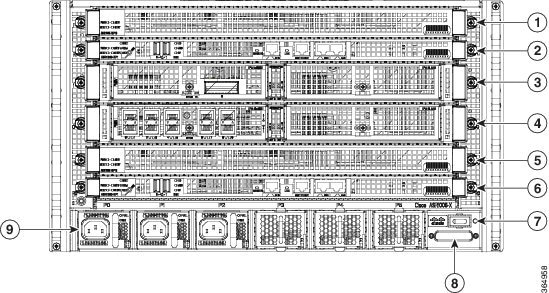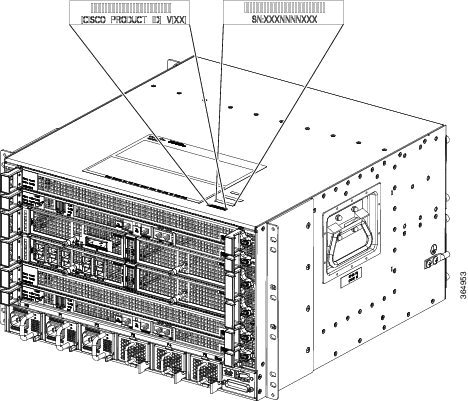The Unique Device Identifier (UDI) is the Cisco product identification
standard for hardware products. A product identification standard removes
barriers to enterprise automation and can help you reduce operating expenses.
The UDI provides a consistent electronic, physical, and associated
business-to-business information product identification standard.
The UDI is a combination of five data elements. The following table
lists the UDI elements.
Table 1. UDI Elements
|
UDI Data Element
|
Electronic Visibility
|
Physical Visibility
|
Description
|
|
PID
|
Yes
|
Yes
|
Product ID, also known as product name, model name, product number
|
|
VID
|
Yes
|
Yes
|
Version ID
|
|
SN
|
Yes
|
Yes
|
Serial number, the unique instance of the PID
|
|
Entity Name
|
Yes
|
__
|
Type, such as chassis, slot, or power supply
|
|
Product Description
|
Yes
|
__
|
Additional product information
|
The combination of serial number and product ID (PID) is unique and
consistent across all Cisco products. The PID that is coded on hardware is
called a base product identifier.
Additional orderable PIDs can be associated to a base PID. For instance, an orderable PID may describe a packaging configuration
for a product or a bundled group of products sold, tested, and shipped together. Specific unique device identifier (UDI) benefits
include the following:
The Cisco product identification standard provides the following
features:
-
Version visibility—Cisco continuously improves products through feature additions. Product changes are indicated by incrementing
the VID, which provides version visibility to help you understand and manage product changes. VID management ensures consistency
of changes from product to product.
-
Operating expense reduction—Cisco UDIs provide accurate and detailed network inventory information; identifying each Cisco
product in a network element through a standard interface. Cisco operating systems can view and use this data, allowing you
to automate your electronic inventory.
-
Consistency across product layers—The UDIs are embedded in the hardware products and cannot be overwritten. Operating and
management systems discover UDIs through standard interfaces and display UDIs in standard outputs. Standard interfaces include
the IETF standard ENTITY-MIB.
The
show
diag
chassis
eeprom
detail command displays the PID, VID, PCB serial
number, hardware revision, and other such information.
The following is sample output from the
show
diag
chassis
eeprom
detail command:
ASR1009-X-2#show diag chassis eeprom detail
MIDPLANE EEPROM data:
EEPROM version : 4
Compatible Type : 0xFF
Controller Type : 3172
Hardware Revision : 0.2
PCB Part Number : 73-16095-02
Board Revision : 01
Deviation Number : 0-0
Fab Version : 01
PCB Serial Number : FXS1842043H
RMA Test History : 00
RMA Number : 0-0-0-0
RMA History : 00
Top Assy. Part Number : 68-5423-01
CLEI Code : SAMPL00XYZ
Product Identifier (PID) : ASR1009-X
Version Identifier (VID) : V00
Chassis MAC Address : 0c09.2a0f.0000
MAC Address block size : 320
Chassis Serial Number : FXS1845Q1QT
Asset ID :
Vendor ID : 00
Environment Monitor Data : 00 08 00 F8
Environment Monitor Data : 04 11 DF 00 0C
ASR1006-X-1#sho diag chassis eeprom detail
MIDPLANE EEPROM data:
EEPROM version : 4
Compatible Type : 0xFF
Controller Type : 3171
Hardware Revision : 0.2
PCB Part Number : 73-16102-03
Board Revision : 01
Deviation Number : 0-0
Fab Version : 01
PCB Serial Number : FXS1842046Z
RMA Test History : 00
RMA Number : 0-0-0-0
RMA History : 00
Top Assy. Part Number : 68-5481-01
CLEI Code : SAMPL00XYZ
Product Identifier (PID) : ASR1006-X
Version Identifier (VID) : V00
Chassis MAC Address : 0c06.2a0e.0000
MAC Address block size : 256
Chassis Serial Number : FXS1846Q415
Asset ID :
Vendor ID : 00
Environment Monitor Data : 00 08 00 F8
Environment Monitor Data : 04 0F BE 00 2F

Note
|
Common Language Equipment Identification (CLEI) code is a ten-digit
character code that identifies a specific product. A CLEI code is applied to
each part within a Cisco ASR 1009-X Router or Cisco ASR 1006-X Router as they
are programmed in manufacturing for shipment to customers.
|







 Feedback
Feedback